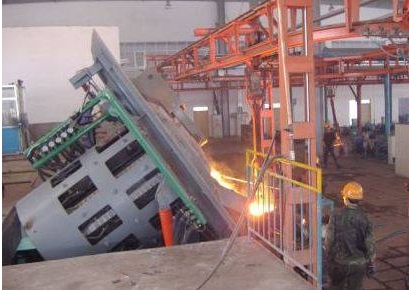- 02
- Sep
The influence of smelting process on energy saving of metal melting furnace
The influence of smelting process on energy saving of metal melting furnace
1 Reasonable ingredients
The scientific management of the charge is of great significance to improve the production efficiency of the metal melting furnace and reduce the energy consumption.
Try to avoid delaying the smelting time due to the adjustment of the composition, and prevent iron (steel) from being scrapped due to unqualified composition, increasing material consumption and power consumption.
The charge must be properly classified according to chemical composition, impurity content and lumpiness, cut large and long scrap steel, and conditionally deal with light and thin materials to ensure smooth charging and reduce smelting time. The lumpiness of the charge should be compatible with the frequency of the power supply. The frequency of the power supply used by the metal melting furnace decreases with the increase of the furnace capacity. The induced current penetration depth layer and the geometrical dimensions of the metal charge are properly matched (when the diameter of the metal charge/the depth of the induced current penetration> 10, the furnace has the highest electrical efficiency) to shorten the heating time, increase the heat rate, and reduce power consumption. For example, a 500Hz intermediate frequency power supply is suitable for 8cm, while a 1000Hz intermediate frequency power supply is suitable for 5.7cm.
2 Extend continuous smelting time
The unit power consumption has a lot to do with the smelting method. The data shows that, taking into account the energy loss required for slag melting and overheating, when the advanced metal melting furnace is cold started, the unit power consumption is 580KW·h/t, and when the hot furnace is operating, the unit power consumption is 505-545KW· h/t. If continuous feeding operation, the unit power consumption is only 494KW·h/t.
Therefore, if possible, it is necessary to arrange concentrated and continuous smelting as much as possible, try to increase the number of smelting furnaces, extend the continuous smelting time, reduce the number of cold furnace smelting, and reduce power consumption.
3 Reasonable smelting operation
(1) Scientific loading;
(2) Adopt a reasonable power supply system;
(3) Use reasonable pre-furnace operation technology to control the amount of subsequent charge added each time. Observe and pound frequently to prevent the charge from “building a shed”. In this smelting operation, the temperature is raised for a short time before pouring, and the molten iron is kept at a lower temperature during the rest of the time, which can reduce the corrosion of the high-temperature molten iron on the furnace, extend the service life of the furnace, and reduce power consumption.
(4) Use reliable temperature control and measurement equipment;
(5) Promote direct reading and shorten the time of casting composition inspection.
(6) Strictly control the furnace temperature of steel and molten iron;
(7) Put in a timely and sufficient amount of heat preservation and covering agent slag remover. After the molten steel is transferred to the ladle, an appropriate amount of insulation covering agent and slag remover should be put in immediately, which can reduce the heat loss during the molten steel sedation pouring process, and the tapping temperature can be appropriately lowered to save power consumption.
4 Strengthen the management and maintenance of smelting equipment to save electricity and reduce consumption
Strengthen the management of metal melting furnaces, standardize the operating process requirements of furnace construction, sintering, smelting, and the maintenance system of the intermediate frequency power supply, effectively improve the age of the furnace, ensure the normal operation of the intermediate frequency power supply, and reduce the power consumption of the smelting.

